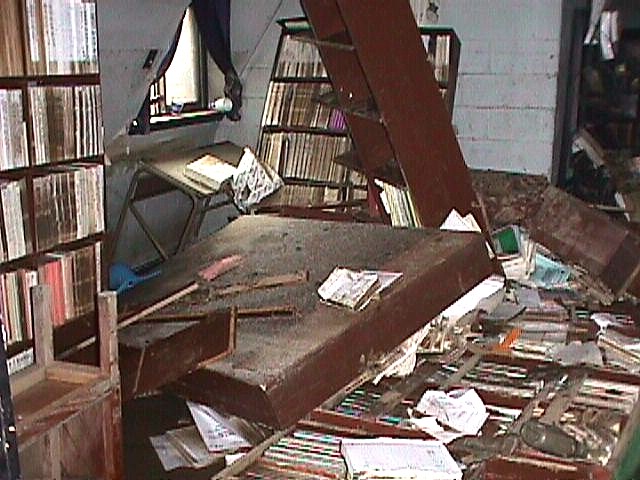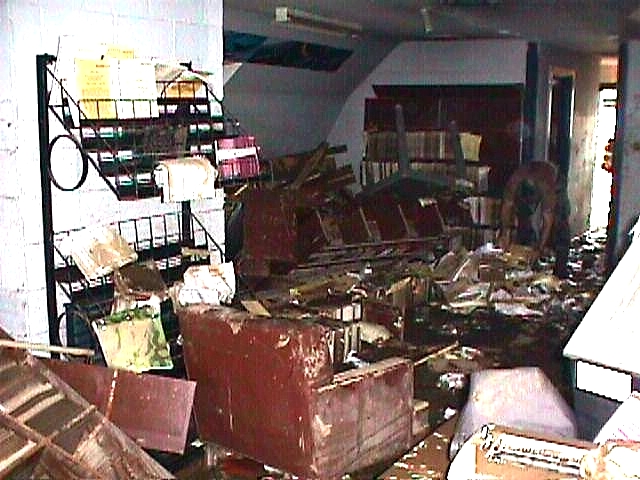 |
This is just inside the door looking to the left. The high water mark, visible on the left wall near the window, indicates just how much water was in the building. The shelf still standing on the left, along with the one face down in front of it, held the Army Training and Evaluation Plans (ARTEP's). The one by the window held DA Pamphlets (DA Pam's). The ones laying flat on the floor in the foreground held Field Manuals (FM's), Soldier Training Publications (STP's) and some miscellaneous manuals. A 4 foot by 3 foot by 2 foot glass case, with a mirror back, encasing a model of the USS Constitution with sails was also on this shelf. |
 |
Further into the building, still on the left side, is where most of the Technical Manuals (TM's) were shelved. The damage was complete. Not a single TM survived the onslaught of muddy waters. The metal rack on the left was the "give away" rack. Keep in mind that this photograph was taken on the second day of clean-up. It took the ten soldiers and the entire previous afternoon to clear away an entrance through the back door. |
 |
This is the area in which I performed my daily functions. My desk is in the foreground. My computer, operational forms and files, and CD player with all my Oldies But Goodies CD's were here. The desk drawers were completely filled with thick sticky dark, and stinking mud. Mr. Conrad Iacomacci, my co-worker, takes a well deserved break from the clean up activities. Having worked together for over nine years, the last four years as the day and night library crew, I was devastated when he passed away on 1 January 1999. |
 |
Standing on one of the fallen shelves, I still canít believe that all is lost. Years of hard work, both tedious and physical, gone in the wake of a single rain storm. At this time the thought of renevation had not really materialized. Just taking out the destroyed stuff and washing the mud off of everything was enough to keep my mind occupied. |
 |
One of the many soldiers who were detailed to assist in the clean up effort, washes down a desk and television set and VCR. All saved items had to have the thick layer of sticky mud hosed off before being turned in for repair or replacement.. |
 |
With the initial cleaning almost complete, all that remains is the mud on the floor and the few pieces of garbage shown here. Only one last step requires attention. That is the hosing of the floor to force the mud out. |
 |
Here, using a hose and bucket, Mr. Iacomacci washes some of the many mud covered office supplies. Believe it or not, most of the office supplies, ie., pens, pencils, staplers, magic markers, and other assorted utensils, were put back as good as new. |
 |
The trash collector prepares to haul off almost the entire interior furnishings of my library. The only things retained were the four metal tables, a metal filing cabinet, one wooden shelf, and my desk. |
 |
Here lies the previously mentioned model of the USS Constitution. I built it eight years ago and placed it in a glass case with a mirrored back. Shaped sheets of balsa wood covered with blue silk simulated the ocean. The ship was the centerpiece of my office. It, too, met its end at the hands of the great flood of 98. |
 |
This marks the completion of the initial building clean up operation. The mud is gone from the floor, except that which gets brought in by folks walking. That can not be helped, as mud is abundant everywhere outside. After this point, the next phase, the building revovation, is soon to begin. |
Go to the Building Renovation Page.
Go Back to the Initial Flood Page.